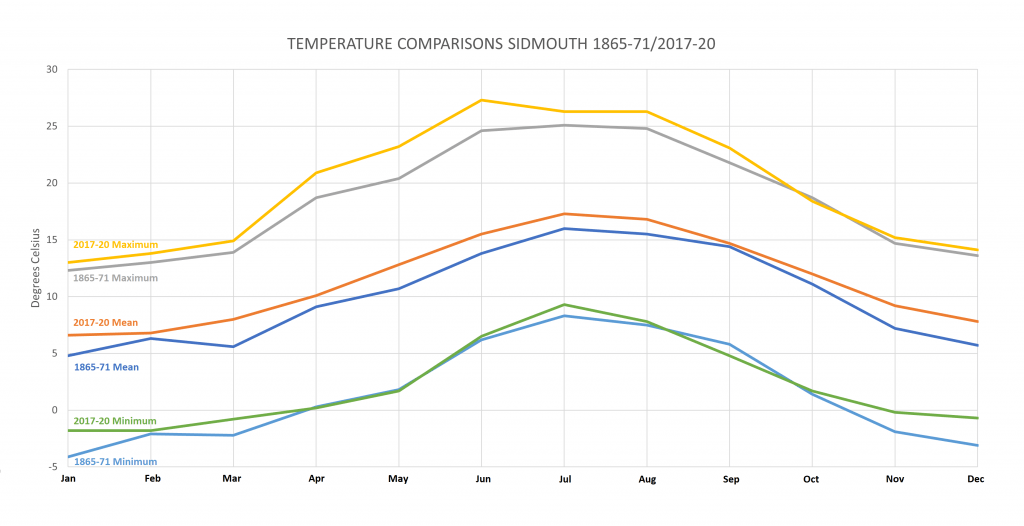“Looking at weather data from 1865-71 and 2017-20, very clear evidence of our climate now being milder in winter and warmer in summer.”
“Only 18% of the Victorian winter months were frost free but 33% of recent winter months have been frost free.”
.
At last year’s climate day at the Sidmouth Science Festival, former head of the Met Office, Dame Julia Slingo led a discussion on the issues:
Public discussion around climate change | Sidmouth Science Festival
Sidmouth Science Festival 2021: Climate Change Science Update – YouTube
These news pages featured the event – and covered a piece from the Sid Valley Biodiversity Group, where Charles Sinclair looked at nature-based solutions:
Climate change and biodiversity: nature-based solutions for Devon – Vision Group for Sidmouth
A further piece from the SVBG, where its author Ed Dolphin finished by saying:
This article just skates on the surface of this very important issue, do find out more about climate change, but you have to be careful. There is a lot of misleading information available, cross check anything you read, including this article.
We can all play our part in fight against climate change | Sidmouth Herald
And if you what to “check anything”, where better to go than a look at the climate for Sidmouth:
These are the current averages.
But if we go back and make comparisons with earlier figures for the climate of the Sid Valley, then some very interesting things emerge.
Ed Dolphin has been studying the flora of the area for a year now – and here is his report:
Here is an extract Ed put together to highlight the changes in climate over the last century and a half:
Regency tales of Sidmouth’s balmy climate were questionable because they had little scientific data to back them up, and they may have been exaggerated to encourage the embryonic tourist industry.
In 1872, local doctor J. Ingleby Mackenzie decided to test the idea. Doctor Mackenzie was a skilled meteorologist who took careful daily records, including the use of a range of thermometers to ensure accurate temperature measurements. He published detailed weather records for Sidmouth from 1865-71.
WILDFLOWERS AND SIDMOUTH’S CHANGING CLIMATE
And here is the accompanying graph which shows the difference of about 1.5 degrees over the period:

Figure 2 shows the mean maximum and minimum temperatures and the monthly means for Sidmouth using data from Mackenzie and the Sidmouth Town Council weather station. It shows that mean temperatures for each month are higher now than 150 years ago. The summer mean has risen from 15.1 deg to 16.5 deg and the winter mean has risen from 5.6 deg to 7.1 deg. The annual mean temperature has risen by 1.5 deg from 10 deg celcius to 11.5 deg.
TEMPERATURE COMPARISONS SIDMOUTH 1865-71/2017-20
Finally, here is a further elucidation from Ed on the data, published with kind permission:
Looking at weather data from 1865-71 and 2017-20, very clear evidence of our climate now being milder in winter and warmer in summer.
Some preliminary analysis:
Annual mean up from 10.0 to 11.5, each of the last four years (ranging from 11.4 to 11.7) has been warmer than any of the years 1865-71 which ranged from 9.5 to 10.7.
The summer mean has risen from 13.3 to 14.5, the mean annual maximum is up from 22.6 to 24.5, the highest recorded Victorian temperature was 27.7 in 1866, 29.1 was recorded in 2018.
The winter mean has risen from 6.8 to 8.4, the mean winter minimum is up from -2.0 to -0.6, the coldest record was -8.6 in 1867, the lowest modern record was -4.7 in 2018, 1865/69/70 and 1871 all recorded lower temperatures than this.
Only 18% of the Victorian winter months were frost free but 33% of recent winter months have been frost free.
See also: A Wealth of Wild Flowers – Sid Valley Biodiversity Group